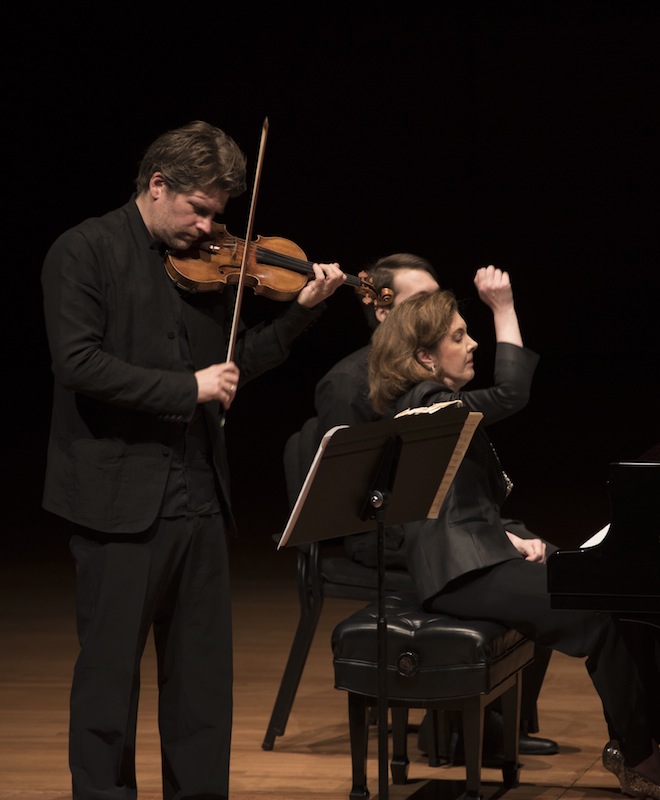Chamber Music Society proves magnifique in French program

Nicolas Dautricourt and Anne-Marie McDermott performed violin sonatas of Debussy and Ravel at Sunday’s concert by the Chamber Music Society of Lincoln Center. Photo: Tristan Cook
A consistent complaint about classical music presenters is that they too frequently rely on a limited core of the enormous historical body of music, making for a predictable (and by design, inoffensive) experience. That criticism has been leveled recently at the Chamber Music Society of Lincoln Center for their recently announced 2017–18 season, which has the rather anodyne title of “The Classical Style.”
While that signals a move toward greater market safety, it’s also not a fair indication of the upcoming CMS season, which is far more varied. But it is useful to push against complacency, especially when the Chamber Music Society can easily produce an absolutely wonderful concert, like the one Sunday afternoon at Alice Tully Hall.
The music came from Debussy and Ravel, obviously well known composers whose chamber music is less often heard than their grand orchestral works. The musicianship came from the Escher String Quartet, pianist Anne-Marie McDermott, and violinist Nicolas Dautricourt, excellent players all. In front of a near-ecstatic crowd, they played both composers’ string quartets and violin sonatas marvelously.
The string quartets and sonatas are masterpieces, with brilliant compositional thinking and craft, force, color, and the kind of deep yet nonspecific expression that makes for an enduring listening experience. The sonatas have the compelling extra of being late-style works: Ravel’s was his final chamber piece and Debussy’s his last major composition before his death. Where the string quartets are dazzling examples of modern thinking applied to a standard model, the sonatas have the appeal of searching personal mysteries.
A great deal of the concert’s pleasure was simply reveling in the way these musicians play this music. In the quartets, the Escher’s wielded a lovely, classic sound—warm, with a slight grain—and projected a feeling of intimacy. They were easily equal to the substantive energy inherent in each work.
The Eschers got to the core of the quartets. With Debussy, that was an emphasis on timbre and orchestration; each lead voice always spoke from within a uniform texture and the playing was highly vocalized, with Pierre LaPointe’s viola particularly outstanding. The music’s velocity, very much an accelerating, un-mossed stone, came through tempos that were both quick and well-chosen. The exception was the “Andantino doucement expressif,” which had a moving, exalted quality.
Ravel’s quartet, with its thematic unity, is much closer to the nineteenth century model of development, but the emphasis is primarily on color and mood. Those qualities were superb, and the hollow pianissimo in the “Très lent” movement was haunting. The second movement, “Assez vif,” is famous and frequently excerpted for Ravel’s vivacious, guitar-like pizzicato, and here the Escher’s combined excitement with lyricism.
The sonic loveliness of Ravel’s music can mask a plangent and unsettling interior, which Dautricourt and McDermott revealed. The violinist’s shining, singing playing expressed an exquisite bittersweet edge in the opening movement, and his Joe Venuti-esque inflections in the middle “Blues: Moderato” were natural and meaningful. Before the last movement, marked “Perpetuum mobile: Allegro,” he turned his music stand to the audience so they could see the thicket of notes, and said “Here comes the workout.” His light-fingered playing belied the exertion, and practice, the music demanded.
McDermott’s crystalline, intelligent musicality is always a joy to hear, and she was a superb accompanist, quick and responsive, managing razor-sharp dynamics and textures. Filling in the spaces in the Debussy sonata, she and Dautricourt went from fire to languor and back again with precision and immediacy, and sounded like they were consuming every one of Debussy’s delicious lines. This focus on forward movement, rather than lingering over juicy spots, was a deeply wise choice in both the sonatas, where meaning and certainty is alway tantalizingly, and pleasurably, just out of reach.
The Chamber Music Society of Lincoln Center presents music by Prokofiev and Lyapunov 6:30 and 9 p.m. Thursday. chambermusicsociety.org